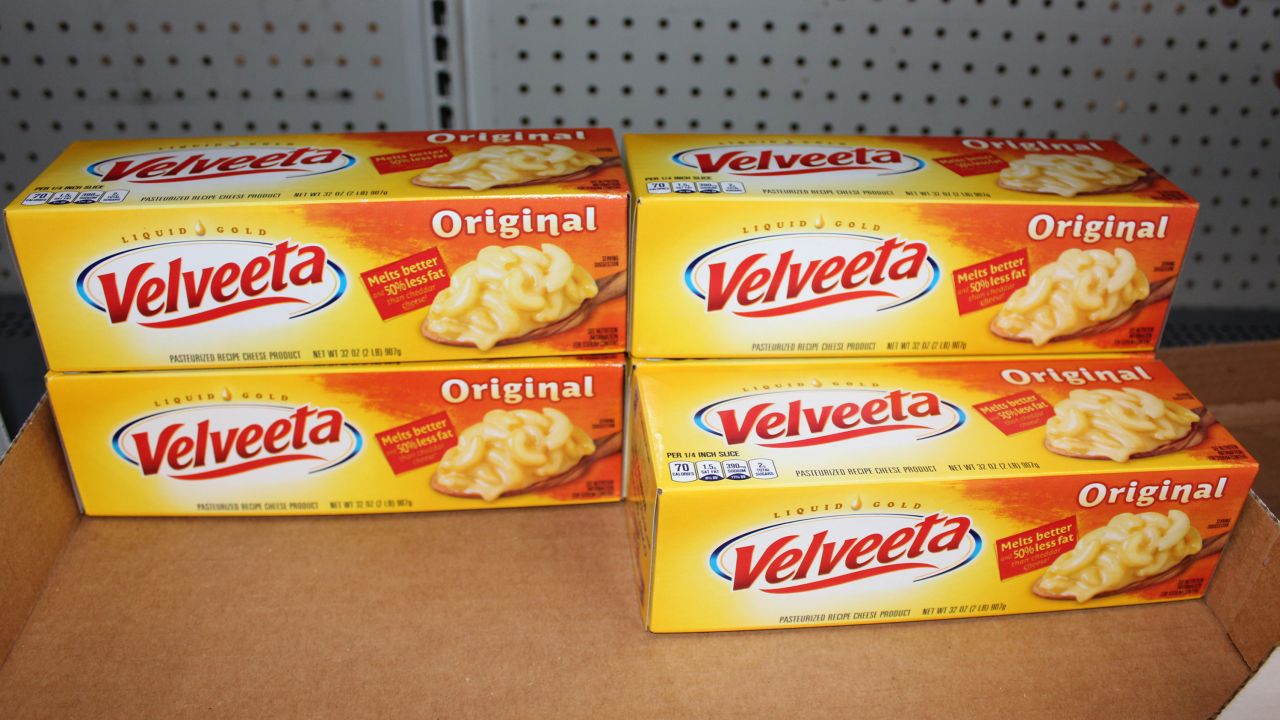

Articles
How To Store A Block Of Cheese
Modified: May 6, 2024
Learn the best methods for storing a block of cheese in this informative article. From wrapping techniques to ideal temperature, we've got you covered!
(Many of the links in this article redirect to a specific reviewed product. Your purchase of these products through affiliate links helps to generate commission for Storables.com, at no extra cost. Learn more)
Introduction
So you’ve purchased a delicious block of cheese, but now you’re wondering how to store it properly to maintain its flavor and texture. Don’t worry, we’ve got you covered! Storing cheese correctly is essential to prevent it from drying out or becoming moldy. In this article, we’ll guide you through the process of storing a block of cheese, whether it’s in the fridge, at room temperature, or even freezing it for later use. So let’s dive in and explore the best practices for storing that precious block of cheese.
Proper cheese storage not only prolongs its shelf life but also ensures that it retains its optimal taste and texture. The key lies in controlling the temperature, humidity, and exposure to air. Different cheese varieties have varying storage requirements, so it’s crucial to consider the specific needs of your chosen cheese. Let’s take a closer look at some factors to consider when choosing the right cheese for storage.
Key Takeaways:
- Properly storing cheese is essential for maintaining its flavor and texture. Whether in the fridge, at room temperature, or frozen, following specific guidelines ensures a delightful culinary experience.
- Choosing the right cheese, proper wrapping, and understanding storage methods are crucial for preserving cheese’s quality and flavor. By following these guidelines, you can enjoy your favorite cheese varieties at their best.
Read more: How To Store Parmesan Cheese Block
Choosing the Right Cheese
When it comes to storing cheese, it is important to select the right cheese for your desired method of storage. Some cheeses are better suited for long-term storage in the fridge, while others may be best enjoyed at room temperature. Here are a few things to consider when choosing the right cheese:
- Hard or Soft Cheese: Hard cheese, such as cheddar or Parmesan, tend to have a longer shelf life and can withstand longer periods in the fridge without losing their flavor or texture. Soft cheese, like Brie or Camembert, are best consumed within a shorter period and are typically stored at room temperature.
- Age of the Cheese: The age of the cheese also impacts its storage needs. Younger cheeses are generally more perishable and should be consumed within a shorter period. Aged cheeses, on the other hand, have a longer shelf life and can be stored for a more extended period.
- Moisture Content: The moisture content of the cheese is another crucial factor. Cheese with higher moisture content, such as fresh mozzarella or feta, should be stored in airtight containers to prevent them from drying out. Cheeses with lower moisture content, like Parmesan or Gouda, are less prone to drying and can be stored without airtight packaging.
- Ingredients and Flavors: Consider the ingredients and flavor profile of the cheese. Some cheeses may contain additional ingredients like herbs, spices, or oils that can affect their storage requirements. It’s essential to check the packaging or consult with the cheesemonger for specific storage instructions.
By considering these factors, you can choose the right cheese that aligns with your storage preferences and ensures the best quality and taste when you’re ready to enjoy it. Now that you’ve selected the perfect cheese, let’s move on to the proper wrapping techniques to keep it fresh and flavorful.
Wrapping the Cheese Properly
One of the key factors in maintaining the freshness and flavor of your cheese is proper wrapping. The right wrapping technique will help protect the cheese from moisture loss, prevent the absorption of odors from other foods, and guard against the growth of unwanted mold. Here are a few guidelines to follow when wrapping your cheese:
- Use Cheese Paper or Wax Paper: Cheese paper is specially designed to allow the cheese to breathe while still providing a barrier against moisture and odors. If you don’t have cheese paper, wax paper can also be used as an alternative. Avoid using plastic wrap as it can cause the cheese to retain moisture and potentially develop off-flavors.
- Wrap Individual Pieces: If you have a large block of cheese, it’s best to slice it or cut it into smaller portions before wrapping. This will help maintain the overall freshness of the cheese, as you can unwrap and use only what you need at a time.
- Wrap Tightly: To prevent air exposure, wrap the cheese tightly in the paper, making sure there are no gaps or loose ends. This will help maintain the cheese’s moisture and protect it from drying out.
- Label the Cheese: It’s always a good idea to label the cheese with its name and the date of purchase. This will help you keep track of its freshness and ensure that you use the oldest cheese first.
Once your cheese is properly wrapped, you have a few options for storing it depending on the type of cheese and your desired storage method. Let’s explore how to store cheese in the fridge and at room temperature.
Storing Cheese in the Fridge
When it comes to storing cheese in the fridge, it’s important to maintain the right temperature and humidity levels to prevent spoilage and maintain the cheese’s flavor and texture. Here are the steps to follow when storing cheese in the refrigerator:
- Find the Ideal Spot: Locate a specific spot in your fridge where the temperature is consistent and not too cold. The cheese drawer or the bottom shelf of the fridge is generally the best place to store cheese.
- Wrap the Cheese: Make sure your cheese is properly wrapped before placing it in the fridge. Use either cheese paper or wax paper to create a breathable barrier around the cheese.
- Keep Cheese Separate: Avoid storing different types of cheese together, as some varieties can impart their flavors onto each other. If possible, place each cheese in its own container or wrap them separately to prevent flavor contamination.
- Avoid Plastic Containers: While it’s tempting to use plastic containers for storage, they can trap moisture and cause the cheese to sweat or develop mold. Stick with wrapping the cheese in paper or using cheese-specific storage containers.
- Check Regularly: It’s a good practice to check your cheese regularly for any signs of spoilage. If you notice any mold growth, unusual odors, or changes in texture, it’s best to discard the cheese to avoid any risk of foodborne illness.
By following these steps, you can extend the shelf life of your cheese and ensure it stays fresh and flavorful. However, it’s important to note that not all cheeses are suitable for fridge storage. In the next section, we’ll discuss how to store certain types of cheese at room temperature.
Storing Cheese at Room Temperature
While the refrigerator is the go-to storage option for most cheeses, there are certain types of cheese that are best enjoyed at room temperature. Storing cheese at room temperature allows it to develop its full flavor and texture. Here are some guidelines for storing cheese at room temperature:
- Choose the Right Cheese: Not all cheeses are suitable for room temperature storage. Hard and aged cheeses like Parmesan, Asiago, or cheddar can safely be stored at room temperature. Soft cheeses like Brie, Camembert, or goat cheese are also commonly enjoyed at room temperature.
- Keep the Cheese Covered: To prevent the cheese from drying out and to protect it from external elements, such as dust or insects, it’s important to cover it properly. Wrap the cheese tightly in cheese paper or wax paper, or place it in a cheese bell or airtight container designed for cheese storage.
- Find the Right Spot: Choose a cool and dry spot in your kitchen to store the cheese. Avoid placing it near direct sunlight, heat sources, or areas prone to temperature fluctuations, such as near the stovetop or oven.
- Monitor the Cheese: Regularly check the stored cheese for any signs of spoilage, such as mold growth or pungent odors. If you notice any signs of spoilage, it’s crucial to discard the cheese to prevent the risk of foodborne illness.
- Consume within a Timely Manner: Unlike refrigerated cheese, cheese stored at room temperature has a shorter shelf life. It’s important to consume the cheese within a reasonable timeframe to ensure it stays fresh and delicious.
Storing cheese at room temperature allows it to soften and develop its flavors, making it a great option for entertaining or serving on a cheese board. However, if you encounter any warmer or more humid environments, it’s always safer to refrigerate the cheese to avoid spoilage.
Now that we’ve covered cheese storage in the fridge and at room temperature, let’s discuss the option of freezing cheese for long-term storage.
Store cheese in the vegetable drawer of the refrigerator, wrapped in wax paper or parchment paper to allow it to breathe. Keep it away from strong-smelling foods to prevent absorption of odors.
Read more: How To Store A Block Of Parmesan Cheese
Freezing Cheese
If you find yourself with more cheese than you can consume before it spoils, freezing is a great option to extend its shelf life. Freezing cheese can be a convenient way to preserve it for future use. However, not all cheeses freeze well, and the texture and flavor may be slightly altered. Here are some guidelines for freezing different types of cheese:
- Hard Cheeses: Hard cheeses like cheddar, Parmesan, or Gouda freeze well. It’s best to shred or grate the cheese before freezing. Place the cheese in an airtight freezer bag, removing as much air as possible, and label it with the date.
- Soft Cheeses: Soft cheeses like Brie or Camembert can be frozen, but they may become softer and lose some of their original texture. It’s recommended to wrap the cheese tightly in plastic wrap or aluminum foil, then place it in an airtight container or freezer bag.
- Cream Cheese: Cream cheese can also be frozen, but it may become crumbly or grainy upon thawing. It’s best to wrap the cream cheese tightly in plastic wrap or foil, or transfer it to an airtight container before freezing.
- Processed Cheese: Processed cheese slices or blocks can be frozen, but they may have a slightly different texture after thawing. Place the cheese slices or blocks in an airtight freezer bag, removing excess air, and freeze them for later use.
When you’re ready to use the frozen cheese, it’s important to thaw it properly. Place the cheese in the refrigerator and allow it to thaw slowly. Avoid thawing cheese at room temperature or in the microwave, as this can cause texture and flavor changes. Once thawed, use the cheese within a reasonable time frame to ensure the best quality.
While freezing cheese is a great way to prevent waste, it’s important to note that the texture and flavor may be slightly affected. It’s recommended to use frozen cheese in cooked dishes or recipes that require melting, as the texture changes may not be as noticeable.
Now that you’re familiar with how to freeze cheese, let’s move on to some general tips for proper handling and care of cheese.
Proper Handling and Care for Cheese
Proper handling and care are essential to preserving the quality and flavor of your cheese. Here are some general tips to follow when handling and caring for cheese:
- Store Cheese in its Original Packaging: If your cheese comes wrapped in its original packaging, it’s best to keep it in that packaging until you’re ready to consume it. The packaging is designed to protect the cheese and maintain its optimal conditions.
- Avoid Touching the Cheese: Whenever possible, handle cheese with clean hands or utensils. Touching the cheese directly with your hands can transfer oils and bacteria, which may accelerate spoilage.
- Trim and Remove Mold: If you notice any mold on the surface of your cheese, it’s essential to trim it off before consuming. Cut at least an inch around the affected area to prevent the mold from spreading.
- Allow Cheese to Reach Room Temperature: For cheeses that are best enjoyed at room temperature, it’s recommended to remove them from the fridge and allow them to come to room temperature before serving. This allows the flavors and aromas to fully develop.
- Keep Cheese Moist: To prevent hard cheeses from drying out, you can place a damp paper towel in the container or use a cheese storage bag that regulates humidity. Just make sure the cheese doesn’t come into direct contact with the paper towel.
- Consume Cheese within Its Shelf Life: Cheese is a perishable product, and its quality deteriorates over time. It’s important to consume cheese within its recommended shelf life for the best flavor and texture.
- Serve Cheese Properly: When serving cheese, it’s best to cut it into small portions or slices rather than leaving it out in its entirety. This prevents excessive exposure to air and helps maintain the quality of the remaining cheese.
By following these tips, you can ensure that your cheese stays fresh, flavorful, and safe to consume. Proper handling and care will enhance your overall cheese experience and allow you to fully enjoy the unique characteristics of each cheese variety.
Now let’s address some frequently asked questions about storing cheese to provide you with even more insights.
Frequently Asked Questions
Q: Can I store cheese in its original packaging?
A: Yes, it’s generally recommended to store cheese in its original packaging until you’re ready to consume it. The packaging is designed to protect the cheese and maintain its optimal conditions.
Q: How long can I store cheese in the fridge?
A: The shelf life of cheese varies depending on the type of cheese. Hard cheeses can be stored for several weeks to months, while soft cheeses have a shorter shelf life of a few weeks. It’s important to check the packaging or consult with the cheesemonger for specific storage durations.
Q: Can I freeze cheese to extend its shelf life?
A: Yes, you can freeze certain types of cheese to extend their shelf life. However, it’s important to note that the texture and flavor may be slightly affected. It’s recommended to shred or grate the cheese before freezing and thaw it slowly in the refrigerator when you’re ready to use it.
Q: Can I eat cheese if it has mold on it?
A: If you notice mold on your cheese, it’s generally safe to trim off the affected area and still consume the rest of the cheese. Cut at least an inch around the moldy part to prevent the mold from spreading.
Q: Can I store cheese at room temperature?
A: Yes, certain types of cheese, such as hard and aged cheeses, can be stored at room temperature. Soft cheeses can also be stored at room temperature, but they may become softer and lose some of their original texture.
Q: How do I know if my cheese has gone bad?
A: Signs of spoiled cheese include mold growth, unusual odors, sliminess, or significant changes in texture. Trust your senses – if the cheese looks or smells off, it’s best to discard it to avoid any risk of foodborne illness.
Q: Can I freeze cheese that has already been thawed?
A: It’s not recommended to refreeze cheese that has already been thawed. Once cheese has been thawed, its texture and quality may be compromised, and it’s best to use it within a reasonable timeframe.
Remember, when in doubt, it’s always best to consult with a cheesemonger or follow the specific storage instructions provided by the manufacturer. Now let’s conclude this article on storing cheese.
Conclusion
Storing cheese properly is crucial for maintaining its flavor, texture, and overall quality. Whether you choose to store it in the refrigerator, at room temperature, or freeze it for future use, following some simple guidelines will help you preserve the cheese and ensure a delightful culinary experience.
When storing cheese in the refrigerator, make sure to wrap it tightly in cheese paper or wax paper to retain moisture and protect it from absorbing odors. Place it in the cheese drawer or the bottom shelf of the fridge for consistent temperature control.
For cheeses that are best enjoyed at room temperature, such as hard or aged varieties, store them covered in a cool and dry spot in your kitchen. Use cheese paper, wax paper, or an airtight container to prevent drying and flavor contamination.
Freezing cheese can extend its shelf life, but it’s important to note that the texture and flavor may be slightly altered. Shred or grate the cheese and store it in airtight containers or freezer bags to maintain its quality. Thaw frozen cheese slowly in the refrigerator before use.
Proper handling and care, such as avoiding touching the cheese with bare hands, trimming off mold, and allowing cheese to reach room temperature before serving, are essential steps in maintaining its freshness and taste.
By following these storage guidelines, you can ensure that your cheese stays delicious and safe to consume. Remember to check the cheese regularly for any signs of spoilage and use it within its recommended shelf life.
Now that you’re equipped with the knowledge of proper cheese storage, you can confidently enjoy your favorite cheese varieties while savoring their exquisite flavors and textures. So go ahead, indulge in the world of cheese, and elevate your culinary experiences to new heights!
Curious about how long that block of cheese can last beyond the fridge? While proper storage is crucial, sometimes you'll want to keep cheese for extended periods. Freezing might be a solution, but knowing the right methods ensures quality and taste aren't compromised. Learn all about freezing techniques and the longevity of cheese preservation in our detailed guide. You'll find practical tips and tricks to keep your cheese fresh for months!
Frequently Asked Questions about How To Store A Block Of Cheese
Was this page helpful?
At Storables.com, we guarantee accurate and reliable information. Our content, validated by Expert Board Contributors, is crafted following stringent Editorial Policies. We're committed to providing you with well-researched, expert-backed insights for all your informational needs.















0 thoughts on “How To Store A Block Of Cheese”